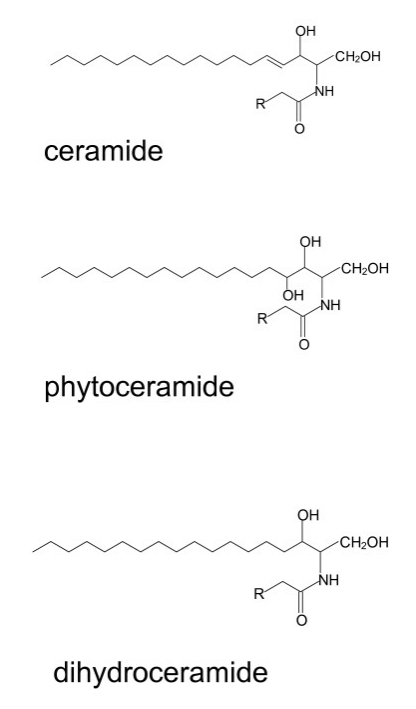Phytoceramide Analysis Service
What are Phytoceramides?
Phytoceramides are natural lipids found in plants, particularly in cereals, rice, and wheat. These lipids are structurally similar to the ceramides found in human skin. Ceramides are a type of sphingolipid, a class of lipids involved in various cellular processes and essential for maintaining the integrity and barrier function of the skin. Phytoceramides, like their human counterparts, play a crucial role in maintaining skin hydration, elasticity, and overall skin health. Due to their plant-based origin, phytoceramides have gained popularity as a natural alternative to synthetic ceramides in skincare and cosmetic products.
Phytoceramide Lipid Composition Analysis
The lipid composition of phytoceramides includes several key components, which are crucial for understanding their biological functions and potential applications. The major lipid components of phytoceramides are:
- Sphingoid Base: Phytoceramides consist of a sphingoid base, which serves as the backbone of the molecule. The most common sphingoid base found in phytoceramides is phytosphingosine, which differs from the sphingosine found in animal-derived ceramides.
- Fatty Acid Chain: Phytoceramides are further characterized by the fatty acid chain attached to the sphingoid base. The fatty acid composition of phytoceramides can vary depending on the plant source. Common fatty acids found in phytoceramides include palmitic acid, oleic acid, and linoleic acid.
- Head Group: The head group of phytoceramides consists of various functional groups, such as hydroxyl groups and sugars, which contribute to their unique properties and interactions with other molecules.
Analyzing the lipid composition of phytoceramides provides valuable information about their structure and potential biological activities.
 Chemical structure of ceramide species (ceramide, phytoceramide and dihydroceramide) (Murakami et al., 2011).
Chemical structure of ceramide species (ceramide, phytoceramide and dihydroceramide) (Murakami et al., 2011).
Phytoceramide Analysis Platform
Phytoceramide analysis relies heavily on the integration of mass spectrometry (MS) and chromatographic techniques, such as high-performance liquid chromatography (HPLC) and gas chromatography (GC). These advanced analytical platforms, combined with state-of-the-art instrumentation, provide powerful tools for comprehensive phytoceramide analysis. At Creative Proteomics, we employ the following instrumental models to deliver accurate and precise results:
Mass Spectrometry (MS):
- Triple Quadrupole Mass Spectrometer (e.g., Agilent 6495 Triple Quadrupole LC/MS System): This instrument offers exceptional sensitivity and selectivity for quantitative analysis of phytoceramides. It enables targeted analysis and quantification of specific phytoceramide species in complex samples.
- Time-of-Flight Mass Spectrometer (e.g., Waters Xevo G2-XS QTof): This high-resolution mass spectrometer provides accurate mass measurement and structural elucidation of phytoceramides. It offers excellent sensitivity and allows for comprehensive profiling of phytoceramides in complex mixtures.
High-Performance Liquid Chromatography (HPLC):
- UHPLC System (e.g., Agilent 1290 Infinity II UHPLC): This ultra-high-performance liquid chromatography system offers precise and efficient separation of phytoceramides. It provides excellent resolution and peak shape, enabling reliable quantification and identification of individual phytoceramide species.
- Reversed-Phase HPLC Column (e.g., Phenomenex Kinetex C18): This column, packed with C18 stationary phase, is commonly used for the separation of phytoceramides. It provides excellent retention and separation of phytoceramide species based on their hydrophobicity.
Gas Chromatography (GC):
- Gas Chromatograph with Flame Ionization Detector (FID) (e.g., Agilent 7890B GC System): GC coupled with FID is widely used for analyzing the fatty acid composition of phytoceramides. It enables the separation and quantification of individual fatty acids derived from phytoceramides.
- Capillary GC Column (e.g., Agilent J&W DB-FFAP): This capillary column is commonly employed for the separation of fatty acids in phytoceramides. It offers excellent resolution and selectivity, allowing for accurate identification and quantification of individual fatty acid species.
The combination of these advanced instrumentation and analytical platforms ensures reliable and comprehensive phytoceramide analysis, enabling you to explore the lipid composition, structural diversity, and bioactivities of phytoceramides with high precision.
Advantages of Phytoceramide Analysis Platforms
Accurate Quantification: Phytoceramide analysis platforms provide precise quantification of various lipid species present in complex mixtures, facilitating reliable data interpretation.
Structural Elucidation: High-resolution mass spectrometry coupled with advanced data analysis tools allows for detailed structural elucidation of phytoceramides, providing insights into their molecular diversity and potential bioactivities.
High Sensitivity and Selectivity: The sensitivity and selectivity of modern analytical techniques ensure reliable detection and quantification of phytoceramides even at low concentrations, enabling a comprehensive analysis of samples with limited availability.
Applications of Phytoceramide Analysis
Plant Physiology and Molecular Biology: Phytoceramides are essential components of plant membranes and contribute to various physiological processes, including stress response, growth, and development. By analyzing phytoceramides, researchers gain insights into the role of these lipids in plant biology.
Functional Food Development: Phytoceramides extracted from plants have been investigated for their potential health benefits. Analysis of phytoceramides helps in evaluating their bioavailability, stability, and potential applications in the development of functional foods and dietary supplements.
Dermatological Research: Phytoceramides have gained attention in dermatology due to their role in promoting skin health. Analyzing phytoceramides in skincare products allows researchers to study their effects on skin hydration, barrier function, and anti-aging properties.
Cosmetics and Personal Care Industry: Phytoceramides are increasingly being incorporated into cosmetics and personal care products for their moisturizing and skin rejuvenating properties. Analyzing phytoceramides ensures the quality, purity, and efficacy of these products.
If you have any questions about our phytoceramide analysis service, please contact us.
Reference
- Murakami, Itsuo, et al. "Phytoceramide and sphingoid bases derived from brewer's yeast Saccharomyces pastorianus activate peroxisome proliferator-activated receptors." Lipids in Health and Disease 10 (2011): 1-11.
* Our services can only be used for research purposes and Not for clinical use.
Services:


 Chemical structure of ceramide species (ceramide, phytoceramide and dihydroceramide) (Murakami et al., 2011).
Chemical structure of ceramide species (ceramide, phytoceramide and dihydroceramide) (Murakami et al., 2011).